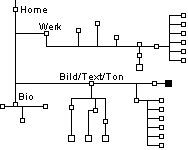|
|
Anna Oppermann: Besinnungsobjekte über das Thema Verehrung -- Anlaß Goethe
I. in: Faltblatt zur Ausstelllung und Fernsehsendung Goethe in Farbe, Hessischer
Rundfunk, Frankfurt 1982
 II. erweiterte und überarbeitete Fassung im Katalog: Vergangenheit, Gegenwart, Zukunft, II. erweiterte und überarbeitete Fassung im Katalog: Vergangenheit, Gegenwart, Zukunft,
Stuttgart 1982, S. 88-91
 English translation English translation
 III.auch in den Katalogen: Anna Oppermann Ensembles 1968-1984, Hamburg und Brüssel 1984, S. 172-183 und in: Anna Oppermann. Das Hehre und das Banale. Besinnungobjekte über das Thema Verehrung -- Anlaß Goethe, Weimar 1996, S. 7 III.auch in den Katalogen: Anna Oppermann Ensembles 1968-1984, Hamburg und Brüssel 1984, S. 172-183 und in: Anna Oppermann. Das Hehre und das Banale. Besinnungobjekte über das Thema Verehrung -- Anlaß Goethe, Weimar 1996, S. 7
 English translation English translation |
|
